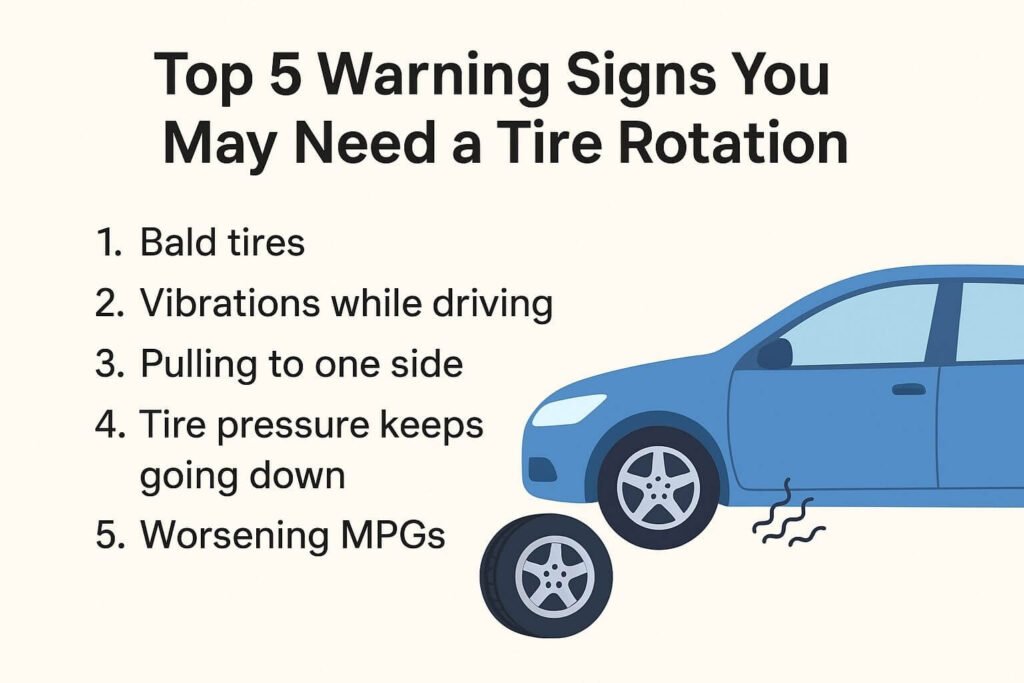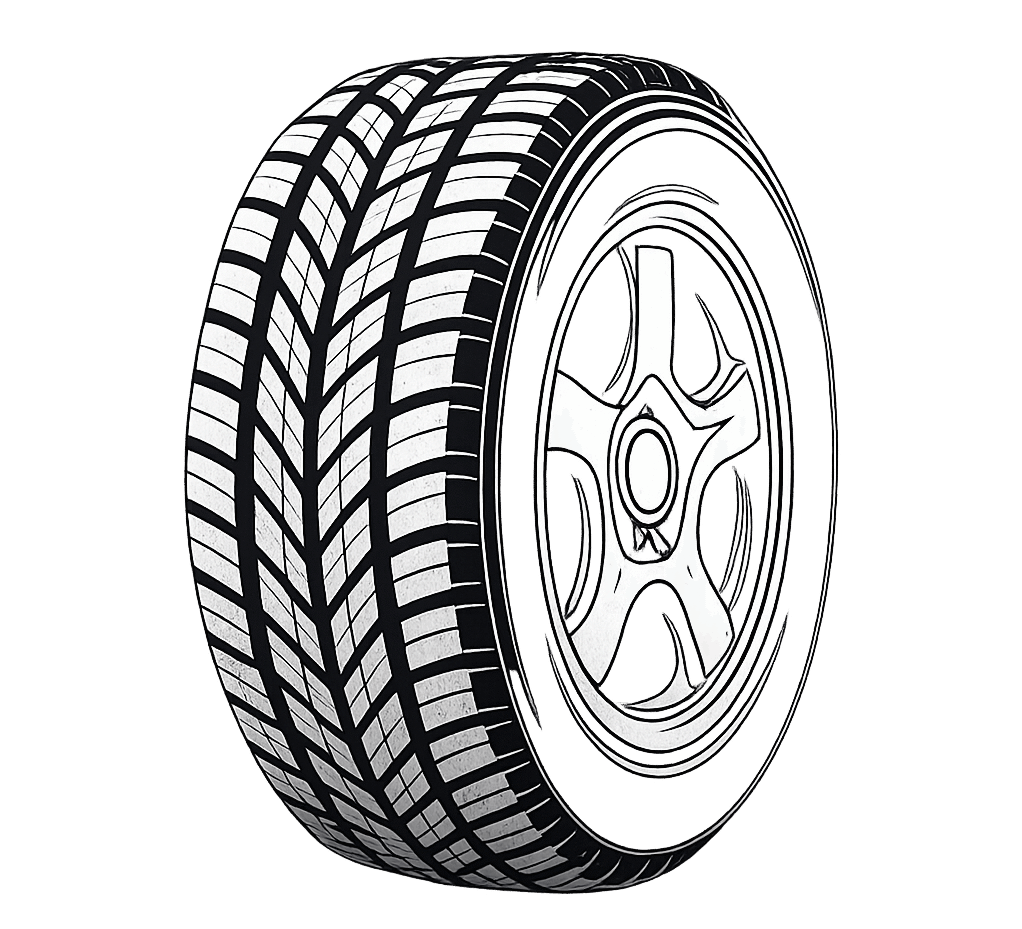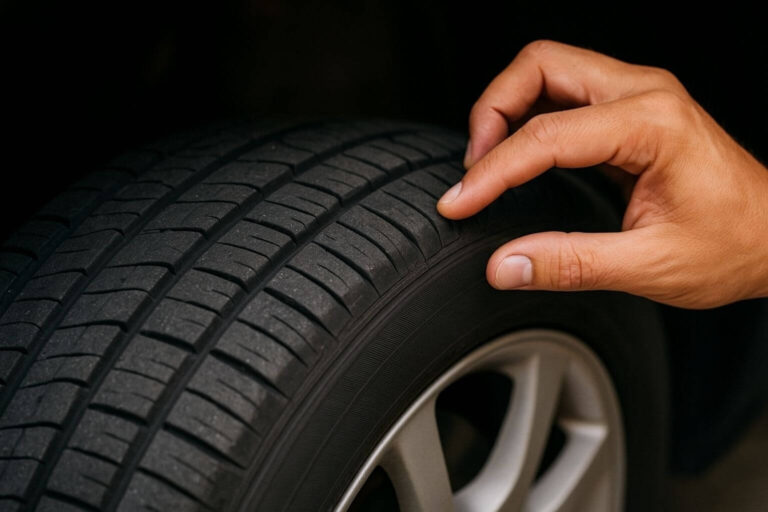How Often Do I REALLY Need to Rotate My Tires?
Last updated on September 11th, 2025
Most drivers should rotate their tires every 5,000–7,500 miles. The exact schedule depends on your vehicle type, tires, and how you drive. This guide explains intervals for FWD/RWD/AWD/EVs, the top warning signs, and quick tips to save money and stay safe.
Why Tire Rotation Matters
Rotating your tires simply means moving each tire to a different wheel position on your car. It’s a small, inexpensive maintenance step that has big benefits. Below are the main reasons it matters — each point written in plain language and with a quick tip you can use.
- Promotes even tread wear
Tires wear differently depending on where they sit (front vs. rear, left vs. right). Rotating them spreads the wear more evenly so no single tire wears out much faster than the others.
Quick tip: Check your tires for uneven wear every few months and rotate sooner if you see one side wearing down faster. - Extends tire lifespan
When wear is even, tires last longer. That means you replace them less often and save money over time.
Quick tip: Keeping a rotation schedule can add many extra miles to a set of tires. - Improves vehicle handling and braking
Evenly worn tires grip the road more consistently. That improves steering, cornering, and braking — especially in wet or slippery conditions.
Quick tip: If your car feels wobbly or pulls to one side, check your tires and consider a rotation before the problem gets worse. - Protects warranty coverage
Many tire warranties require regular rotations to remain valid. If you skip rotations, you may lose the ability to claim a warranty for premature wear.
Quick tip: Keep rotation receipts or a simple log in your glovebox to show you followed the schedule.
Bottom line: Tire rotation is quick and inexpensive, but it protects safety, performance, and your wallet. Aim to rotate on a regular schedule (for most drivers, about every 5,000–7,500 miles or with routine oil changes).
How Often Do I REALLY Need to Rotate My Tires?
Here’s a simple, practical guide to how often to rotate tires for different vehicles — and the main factors that can change the schedule.
Recommended intervals
- FWD (front-wheel drive): 5,000–7,000 miles
Front tires do more steering and braking, so they wear faster. Rotate a bit sooner to even things out. - RWD (rear-wheel drive): 6,000–8,000 miles
Rear tires tend to wear more on these cars, so you can wait a little longer than FWD. - AWD / 4WD: 5,000–6,000 miles
All-wheel systems are sensitive to mismatched tread depth, so rotate more often to protect the drivetrain. - EVs (electric vehicles): about 5,000 miles
EVs are heavier and deliver power instantly, which speeds up tire wear — rotate more frequently.
Factors that can make you rotate sooner
- Driving style — City stop-and-go driving wears tires faster than steady highway cruising. If you mostly drive in town, rotate earlier.
- Heavy loads or towing — Carrying weight or towing makes tires wear faster. Drivers who haul often should rotate more often.
- Tire type — Performance or summer tires can wear quicker than all-season tires. Winter tires have different wear patterns too. Adjust the interval based on the tire type.
Quick, actionable tips
- Pair rotations with oil changes if your oil change interval is around 5,000 miles — it’s an easy reminder.
- Check your owner’s manual — some manufacturers give a specific rotation interval. Follow that for warranty reasons.
- Watch for warning signs (vibrations, pulling, uneven tread) and rotate immediately if you see them.
- Keep a log or receipt so you can prove rotations if a warranty claim comes up.
Bottom line: Use the ranges above as a starting point, then adjust earlier if you drive in the city, carry heavy loads, use performance tires, or drive an EV. When in doubt, rotate sooner rather than later — it’s cheap insurance for safety and tire life.

Top 5 Warning Signs You May Need a Tire Rotation
Checking your tires regularly can save you money, improve safety, and keep your car running smoothly. Here are the top signs that it’s time for a rotation:
1. Bald Tires
Look closely at your tires. If any spots have no tread left — smooth areas where the grooves are gone — your tires not only need to be rotated but may need replacement. Bald tires reduce grip and are dangerous, especially in wet conditions.
2. Vibrations While Driving
If your car shakes or vibrates when you’re driving, especially at highway speeds, it could be uneven tire wear. Vibrations aren’t always caused by tires, but they are a strong warning sign that you should have them checked. A quick visit to a tire shop or mechanic can confirm whether a rotation or other maintenance is needed.
3. Pulling to One Side
Your car should drive straight when you let go of the steering wheel. If it drifts slightly to one side, uneven tire wear or alignment issues could be the cause. When you get a wheel alignment, your mechanic will usually rotate the tires to prevent future uneven wear.
4. Tire Pressure Keeps Going Down
If one tire keeps losing air while the others stay full, it might have a weak spot caused by uneven wear. Your car’s TPMS (Tire Pressure Monitoring System) may warn you. Refill the tire and watch it closely — if the warning light comes back, schedule a rotation or inspection at your service center.
5. Worsening Fuel Efficiency (MPGs)
Uneven tires can make your car work harder, which can reduce fuel efficiency by up to 3%. That might not sound like much, but over time, it can cost more than a routine tire rotation. Rotating your tires helps distribute weight evenly and keeps your car running efficiently.
Tip: Even if you don’t see these signs, rotating your tires on schedule (every 5,000–7,500 miles for most vehicles) is the best way to prevent problems before they start.
What Happens if I Don’t Rotate My Tires?
Skipping tire rotations might seem like a small thing, but it can cause several problems — some costly and others dangerous. Here’s what can happen if you don’t rotate your tires regularly:
- Tires wear unevenly and wear out faster
Front, rear, or corner tires may wear more quickly than others. Uneven wear means you’ll have to replace tires sooner, costing you more money. - Poor vehicle handling
Uneven tires can make your car feel unstable. Steering, braking, and cornering may not work as well, especially in wet or slippery conditions. This is a safety risk for you and your passengers. - You could void your tire warranty
Many tire warranties require regular rotations. Skipping rotations may make your warranty invalid if you need a replacement. - Lower fuel efficiency
Uneven tires put extra strain on your car. Your engine has to work harder, which can reduce your miles per gallon and increase fuel costs. - Drivetrain issues for AWD/4WD vehicles
On all-wheel or four-wheel drive vehicles, mismatched tire tread can put stress on the drivetrain. This can lead to expensive repairs if rotations are ignored.
Bottom line: Rotating your tires is a small step that protects safety, saves money, and keeps your car running smoothly. It’s far cheaper and easier than dealing with worn-out tires or repair bills later.
Schedule a Tire Rotation
Rotating your tires on a regular schedule is one of the easiest ways to keep your car safe and your tires lasting longer. Here’s how to do it:
How to Rotate Tires
- DIY vs Professional Service
You can rotate tires at home if you have the right tools and know the rotation pattern. However, most drivers prefer a professional service to ensure it’s done correctly and safely. - Typical Cost
A tire rotation usually costs $25–$50 at a shop. It’s a small price compared to replacing worn-out tires early. - Recommended Frequency
Most vehicles benefit from rotating tires every 5,000–7,500 miles, or you can pair it with your oil changes for an easy reminder.
Pro Tips
- Keep a log or phone reminder
Note the date and mileage each time you rotate your tires so you never miss a rotation. - Follow the correct rotation pattern
Rotation patterns depend on your vehicle type:- FWD: front-to-back, sometimes crisscross
- RWD: rear-to-front, sometimes crisscross
- AWD/4WD: follow manufacturer recommendations
If you’re unsure, let a professional handle it to avoid mistakes.
- FWD: front-to-back, sometimes crisscross
Scheduling regular rotations is simple, inexpensive, and keeps your tires wearing evenly. With a little planning, you can prevent uneven wear, improve safety, and save money over time.
Benefits of Regular Tire Rotations
Rotating your tires regularly may seem small, but it has several important benefits that help your car, your safety, and your wallet:
- Longer tire life → saves money
Evenly rotated tires wear more slowly, which means you won’t need to replace them as often. This can save hundreds of dollars over the life of your car. - Better handling → safer driving
Tires that wear evenly grip the road better. This improves steering, braking, and overall control, making your car safer to drive in all conditions. - Warranty compliance
Many tire warranties require regular rotations. Following the schedule keeps your warranty valid if you ever need a replacement. - Improved fuel efficiency
Uneven tires can make your engine work harder, which lowers gas mileage. Rotating your tires helps your car run more efficiently, saving fuel over time.
Bottom line: Regular tire rotations are quick, inexpensive, and protect your car, your safety, and your money. Think of it as a small investment for long-term benefits.
Cost, Pricing & Value
Rotating your tires is one of the most affordable ways to protect your car and save money over time. Here’s what you need to know:
Average Cost per Rotation
- Most tire rotations cost $25–$50 at a professional shop.
- DIY rotations can be free if you have the tools and know-how, but most people prefer to leave it to the experts to avoid mistakes.
Annual Cost vs Potential Savings
- Rotating tires regularly prevents uneven wear and extends their life.
- By following a rotation schedule, you may avoid replacing tires earlier than necessary, saving hundreds of dollars per year.
- The small cost of a rotation is far less than the cost of new tires caused by skipping rotations.
DIY vs Professional Service
| Option | Pros | Cons |
| DIY | Free if you have tools; learn about your car | Risk of incorrect rotation; time-consuming |
| Professional | Done correctly and safely; may include inspection | Costs $25–$50; requires a trip to the shop |
Regular tire rotations are inexpensive and provide big value. Spending a small amount now can save money, improve safety, and extend the life of your tires.
Customer Feedback / Real-World Experiences
Hearing from other drivers can make the benefits of tire rotation easier to understand. Here are some common experiences:
- Skipped Rotations → Costly Replacements
Many drivers who ignored tire rotations noticed that their front tires wore out much faster than the back ones. This led to bald spots, poor traction, and expensive early replacements—sometimes years before the tires should have worn out. - Regular Rotations → Smooth Driving and Savings
On the other hand, drivers who rotated their tires every 5,000–7,000 miles found that their tires lasted longer, handled better in bad weather, and saved them money in the long run. - Peace of Mind
Some drivers also mentioned feeling safer knowing that their tires wore evenly, which gave them more confidence on the road.
Takeaway: Real-world experience shows that skipping rotations often leads to problems, while staying on schedule improves performance, safety, and savings.
FAQs
Q: Can I rotate tires myself?
Yes, you can if you have the right tools (a jack, jack stands, and a torque wrench). However, many drivers prefer going to a shop because it’s quicker, safer, and usually costs only $25–$50.
Q: How do I know if my car is AWD, FWD, or RWD?
Check your owner’s manual or look up your vehicle’s specs online. In short:
- FWD (Front-Wheel Drive): Most sedans and small SUVs.
- RWD (Rear-Wheel Drive): Many trucks and sports cars.
- AWD/4WD (All-Wheel or Four-Wheel Drive): Many SUVs and off-road vehicles.
Q: Will tire rotations improve fuel efficiency?
Yes, keeping tires evenly worn reduces rolling resistance. That means your car doesn’t have to work as hard, and you save on gas—sometimes up to 3% over time.
Q: How long does a rotation take at a shop?
Usually about 30 minutes. If it’s done with an oil change, it doesn’t add much extra time.
Conclusion
Rotating your tires isn’t complicated or expensive, but it makes a big difference. Regular rotations help your tires last longer, keep your car safe, and even save you money on gas.
For most vehicles, the sweet spot is every 5,000–7,500 miles, depending on your car’s drivetrain. But don’t just go by mileage—keep an eye out for warning signs like bald spots, vibrations, or uneven wear.
A quick rotation today can prevent costly tire replacements tomorrow. Think of it as small maintenance with big rewards.








